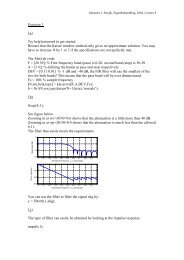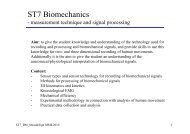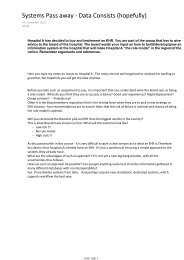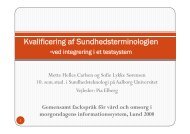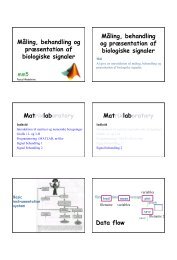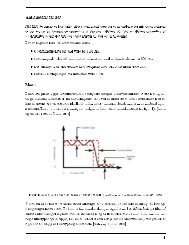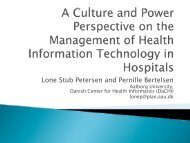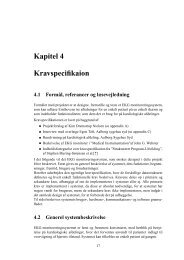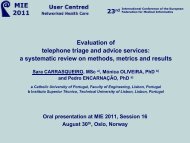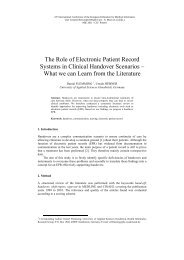Application of Personas in User-Centered Design of Medical ...
Application of Personas in User-Centered Design of Medical ...
Application of Personas in User-Centered Design of Medical ...
Create successful ePaper yourself
Turn your PDF publications into a flip-book with our unique Google optimized e-Paper software.
<strong>Application</strong> <strong>of</strong> <strong>Personas</strong> <strong>in</strong> <strong>User</strong>-<strong>Centered</strong><br />
<strong>Design</strong> <strong>of</strong> <strong>Medical</strong> Informatics Systems<br />
and Services<br />
Tr<strong>in</strong>e KROGSTAD a,1 , Tatjana M. BURKOW a , Luis FERNANDEZ-LUQUE b<br />
a Norwegian Centre for Integrated Care and Telemedic<strong>in</strong>e, UNN, Tromsø, Norway<br />
b Northern Research Institute – Norut, Tromsø, Norway<br />
1. Introduction<br />
Abstract. The Persona technique is widely used and adapted with<strong>in</strong> s<strong>of</strong>tware<br />
product development and consult<strong>in</strong>g as a supplement to other qualitative and<br />
quantitative <strong>User</strong>-<strong>Centered</strong> <strong>Design</strong> techniques. However, there has not been<br />
published as many examples <strong>of</strong> its use with<strong>in</strong> the doma<strong>in</strong> <strong>of</strong> <strong>Medical</strong> Informatics.<br />
Our poster will provide a short <strong>in</strong>troduction to the Persona technique based on<br />
literature f<strong>in</strong>d<strong>in</strong>gs and our own <strong>in</strong>itial experiences and assessments.<br />
Keywords. Human-Computer Interaction, <strong>User</strong>-<strong>Centered</strong> <strong>Design</strong>, <strong>Personas</strong><br />
<strong>Personas</strong> are used as a supportive tool for decid<strong>in</strong>g who is be<strong>in</strong>g designed for and to<br />
make the design support particular types <strong>of</strong> users achieve their goals. It was Cooper<br />
that <strong>in</strong>troduced <strong>Personas</strong> for the s<strong>of</strong>tware <strong>in</strong>dustry as a design and communication tool<br />
[1]. The Persona technique has s<strong>in</strong>ce been widely adopted, extended and described [2].<br />
Quantitative and qualitative data are used to describe fictitious persons, called<br />
<strong>Personas</strong>, each represent<strong>in</strong>g different user categories with shared characteristics. These<br />
user representations are based on <strong>in</strong>formation like demographics, roles, activities,<br />
behavior patterns, motivations, goals, attitudes, frustrations, environment, skills,<br />
limitations and experience levels. Each Persona do typically have one or more photos<br />
or illustrations to br<strong>in</strong>g the Persona to life, and a Persona description <strong>in</strong>clud<strong>in</strong>g a name<br />
and some essential characteristics extracted from the collected data.<br />
2. Prelim<strong>in</strong>ary f<strong>in</strong>d<strong>in</strong>gs<br />
23 rd International Conference <strong>of</strong> the European Federation for <strong>Medical</strong> Informatics<br />
<strong>User</strong> Centred Networked Health Care - A. Moen et al. (Eds.)<br />
MIE 2011 / CD / Posters<br />
The Persona technique is a useful tool <strong>in</strong> many sett<strong>in</strong>gs. Even if there are certa<strong>in</strong><br />
fundamentals and many usage recommendations, there is no s<strong>in</strong>gle “correct”<br />
application <strong>of</strong> it. In practice there are several different uses <strong>of</strong> the technique [3]. It is to<br />
a great extent a matter <strong>of</strong> adaption to the specific context and use, to f<strong>in</strong>d a balance<br />
between putt<strong>in</strong>g adequate versus too much effort <strong>in</strong>to the Persona process, be aware <strong>of</strong><br />
1 Correspond<strong>in</strong>g Author: Tr<strong>in</strong>e Krogstad, Norwegian Centre for Integrated Care and Telemedic<strong>in</strong>e,<br />
University Hospital <strong>of</strong> North-Norway, P.O. Box 6060, NO-9038 Tromsø, Norway; Email:<br />
tr<strong>in</strong>e.krogstad@telemed.no.
the strengths and weaknesses <strong>of</strong> this technique, and to use it <strong>in</strong> comb<strong>in</strong>ation with other<br />
tools. Also, it should be noted, that assessments <strong>of</strong> the technique are <strong>of</strong>ten experience<br />
and theoretically funded, and not extensively tested <strong>in</strong> comparison studies. Overall, the<br />
Persona technique can be a supplemental aid <strong>in</strong> the process <strong>of</strong> def<strong>in</strong><strong>in</strong>g what a system<br />
should do, and <strong>in</strong> the design, evaluation and market<strong>in</strong>g <strong>of</strong> it. A central part is its means<br />
for visualization <strong>of</strong>, agreement on and communication <strong>of</strong> target user groups (actors <strong>in</strong><br />
scenarios and use cases). This user concretiz<strong>in</strong>g may complement other more abstract<br />
or functional focused approaches. We believe it is a technique that more <strong>Medical</strong><br />
Informatics project could benefit from explor<strong>in</strong>g. As <strong>in</strong> other contexts, the <strong>Personas</strong><br />
then details more on the specific health and care related characteristics <strong>of</strong> <strong>in</strong>terest [4-7].<br />
For our own part, the mak<strong>in</strong>g <strong>of</strong> <strong>Personas</strong> may be used partly for visualiz<strong>in</strong>g the<br />
chronically ill and their needs - utiliz<strong>in</strong>g this as a basis for f<strong>in</strong>d<strong>in</strong>g relevant new homebased<br />
eHealth services to develop, and to prioritize and choose between these.<br />
Similarly, when we have an <strong>in</strong>itial idea <strong>of</strong> a technology or service that might be useful,<br />
the Persona technique can be used as an aid <strong>in</strong> explor<strong>in</strong>g and decid<strong>in</strong>g which user<br />
groups with<strong>in</strong> the particular patient group to target, and design<strong>in</strong>g to meet the needs <strong>of</strong><br />
these. The latter variant is how we have used the technique so far. Further, when<br />
different project participants (competences and roles) are <strong>in</strong>volved, there is a need for<br />
communicat<strong>in</strong>g knowledge about and specifications <strong>of</strong> target user groups. With<strong>in</strong> our<br />
small applied research group there are already a high degree <strong>of</strong> both <strong>in</strong>dividual and<br />
shared knowledge about, and attention, to users. But we do still consider <strong>Personas</strong><br />
useful to make the knowledge about our users explicit and commonly agreed on. They<br />
assist <strong>in</strong> mak<strong>in</strong>g the user groups visible and live <strong>in</strong> discussions amongst the project<br />
team members. The researchers can po<strong>in</strong>t to someth<strong>in</strong>g from the literature or a field<br />
observation that is relevant for one Persona, whilst the health care personnel may make<br />
another po<strong>in</strong>t based on their daily experience with this subset <strong>of</strong> users. Further, s<strong>in</strong>ce<br />
we have a long-term research and development activity, the use <strong>of</strong> <strong>Personas</strong> provides<br />
us with an opportunity for knowledge transfer as the team changes over time. With<br />
gradual expansion <strong>of</strong> our portfolio <strong>of</strong> Personal eHealth systems, services and research<br />
topics [8], our <strong>Personas</strong> may also develop and <strong>in</strong>crease <strong>in</strong> accordance with this.<br />
References<br />
[1] Cooper A. The Inmates Are Runn<strong>in</strong>g the Asylum. Macmillan Publish<strong>in</strong>g Co., Inc.; 1999.<br />
[2] Pruitt J, Adl<strong>in</strong> T. The Persona Lifecycle: Keep<strong>in</strong>g People <strong>in</strong> M<strong>in</strong>d Throughout Product <strong>Design</strong>. Morgan<br />
Kaufmann Publishers Inc.; 2005.<br />
[3] Chang Y-n, Lim Y-k, Stolterman E. <strong>Personas</strong>: from theory to practices. Proceed<strong>in</strong>gs <strong>of</strong> the 5th Nordic<br />
conference on Human-computer <strong>in</strong>teraction: build<strong>in</strong>g bridges; Lund, Sweden. 1463214: ACM; 2008. p.<br />
439-42.<br />
[4] Le Rouge C, Ma J. <strong>User</strong> Pr<strong>of</strong>iles and <strong>Personas</strong> <strong>in</strong> Consumer Health Technologies. 2010 43rd Hawaii<br />
International Conference on System Sciences. 2010:1-10.<br />
[5] Koch S, Sheeren A, Staggers N. Us<strong>in</strong>g personas and prototypes to def<strong>in</strong>e nurses' requirements for a<br />
novel patient monitor<strong>in</strong>g display. Stud Health Technol Inform. 2009;146:69-73.<br />
[6] Pick<strong>in</strong>g R, Rob<strong>in</strong>et A, Grout V, McG<strong>in</strong>n J, Roy A, Ellis S, et al. A Case Study Us<strong>in</strong>g a Methodological<br />
Approach to Develop<strong>in</strong>g <strong>User</strong> Interfaces for Elderly and Disabled People. The Computer Journal. 2010<br />
July 1, 2010;53(6):842-59.<br />
[7] Henry S. Just Ask: Integrat<strong>in</strong>g Accessibility Throughout <strong>Design</strong>. Madison, WI: ET\Lawton; 2007 [cited<br />
2011 April 29th]; Available from: http://www.uiaccess.com/accessucd/.<br />
[8] Vognild LK, Burkow TM, Luque LF. The MyHealthService approach for chronic disease management<br />
based on free open source s<strong>of</strong>tware and low cost components. Conf Proc IEEE Eng Med Biol Soc.<br />
2009;2009:1234-7.



